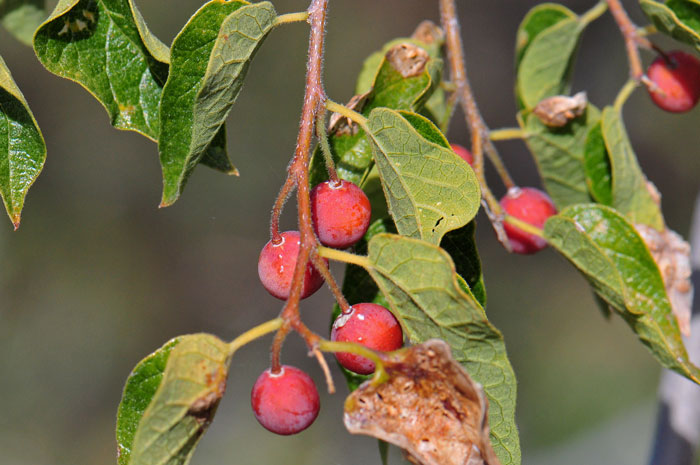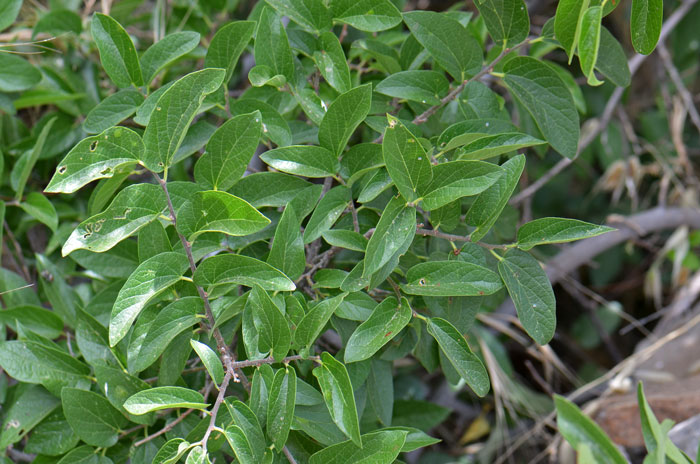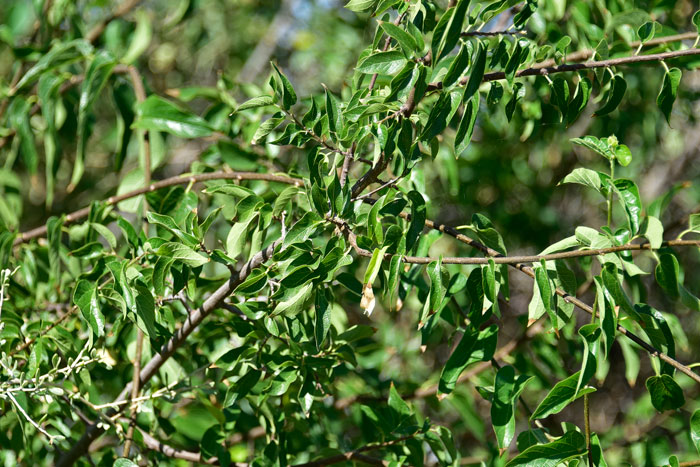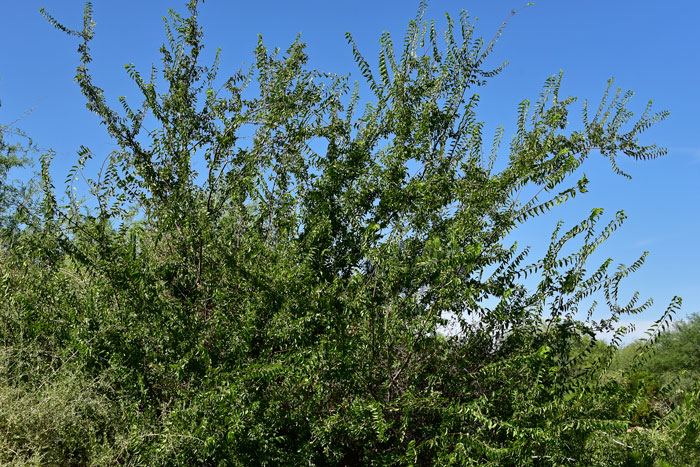Celtis reticulata, Netleaf Hackberry




Scientific Name: Celtis reticulata
Common Name: Netleaf Hackberry
Also Called: Acibuche, Netleaf Hackberry, Netleaf Sugar Hackberry, Palo Blanco, Sugar Hackberry, Texas Sugarberry, Western Hackberry
Family: Ulmaceae, Elm family
Synonyms: (Celtis douglasii, Celtis occidentalis var. reticulata, Celtis reticulata, Celtis reticulata var. vestita, Celtis laevigata var. reticulata)
Status: Native
Duration: Perennial
Size: Up to 48 feet tall more or less; trunks to 20 inches or so.
Growth Form: Large shrubs and small trees; plants not armed; bark gray and smooth, deeply furrowed or textured with ridges or rings at maturity.
Leaves: Green; alternate; deciduous; highly variable, ovate to lanceolate, asymmetrical, about ½ inch long and up to 3 or 3½ inches; upper leaf surface (adaxial) gray green, yellow green below (abaxial); often leathery, numerous insect galls; margins entire or serrate on the upper end (distal).
Flower Color: Inconspicuous; axillary inflorescence usually stalked (peduncle); flowers may be bisexual or unisexual on the same plant; fruit a spheric, persistent orange,red or green 1-seeded drupe.
Flowering Season: March to April.
Elevation: 2,500 to 5,500 feet.
Habitat Preferences: Along streams, stream banks, canyons, riparian areas.
Recorded Range: Celtis reticulata is found in the southern and western parts of the United States: AZ, CA, CO, ID, KS, LA, NM, NV, OK, OR, TX, UT, WA, WY. It is also native to Baja California and Mexico. In Arizona it occurs throughout the state with few or no records in La Paz and Yuma counties.
North America & US County Distribution Map for Celtis reticulata. shown as Celtis laevigata var. reticulata.
U.S. Weed Information: No information available.
Invasive/Noxious Weed Information: No information available.
Wetland Indicator: In North America Celtis reticulata has the following wetland designations: Arid West, FAC; Atlantic and Gulf Coastal Plain, FACW; Eastern Mountains and Piedmont, FACW; Great Plains, FAC; Midwest, FACW; Western Mountains, Valleys, and Coast, FACW.
FAC = Facultative, occur in wetlands and non-wetlands
FACW = Facultative Wetland, usually occur in wetlands, but may occur in non-wetlands.
Threatened/Endangered Information: No information available.
In the Southwestern United States, Arizona and Utah each have 2 species of Celtis, California and New Mexico each have 3 species, Nevada has 1 species and Texas has 6 species. All data is approximate and subject to taxonomic changes.
There are 5 varieties in Celtis laevigata;
Celtis laevigata var. brevipes, Sugarberry, (AZ, UT);
Celtis laevigata var. laevigata, Sugarberry, (AL, AR, DC, FL, GA, IL, IN, KS, KY, MD, MO, MS, NC, NE, OH, OK, SC, TN, TX, VA, WV);
Celtis laevigata var. reticulata, Netleaf Hackberry, (AZ, CA, CO, ID, KS, LA, NM, NV, OK, OR, TX, UT, WA, WY);
Celtis laevigata var. smallii, Small's Hackberry, (AL, GA, KY, NC, SC, TN, VA);
Celtis laevigata var. texana, Texan Sugarberry, (AR, IL, KS, MO, NM, OK, TX).
Comments: Celtis reticulata provides shelter and food for wildlife including birds, mammals and butterflies.
In Southwest Desert Flora also see Spiny Hackberry, Celtis pallida.
Celtis reticulata has been used for food and other purposes by southwestern United States indigenous peoples.
Acoma Food, Fruit, Berries extensively used as food.
Apache, Chiricahua & Mescalero Food, Bread & Cake, Fruit ground, caked and dried for winter use.
Havasupai Other, Fuel, Wood used for firewood.
Navajo Dye, Red-Brown, Leaves and branches boiled into a dark brown or red dye for wool.
Navajo, Kayenta Drug, Gastrointestinal Aid, Plant used for indigestion.
Papago Fiber, Clothing, Bark used to make sandals.
Tewa Other, Tools, Wood used to make handles for axes and hoes.
See ethno-botanical uses at Native American Ethnobotany, University of Michigan, Dearborn.

